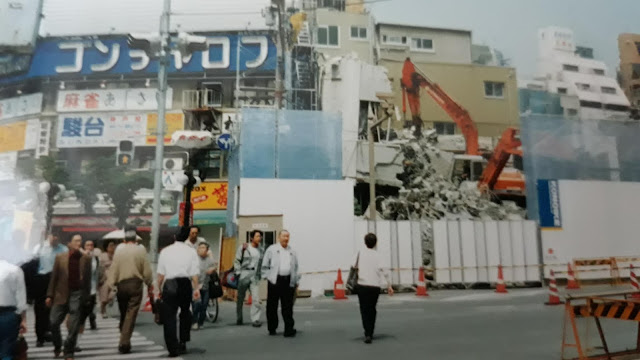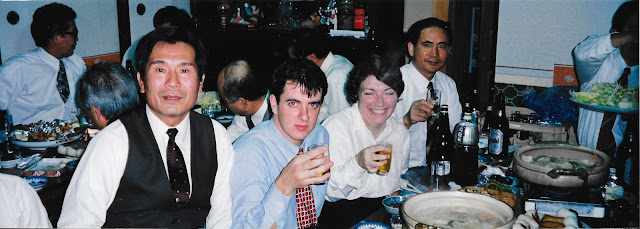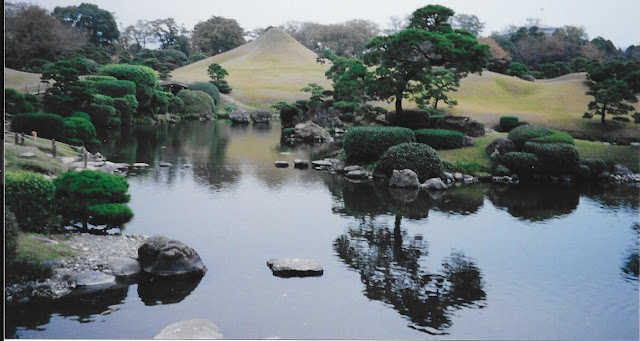January arrived pretty quickly in this contract year where I was counting the days to head back home. Or was I doing so much counting now? When Jason and Debbie arrived around the 19th for the holidays, I really hadn't had time to count! From July and August with homesickness, heat sickness and so many adaptations to food, language, and you name it, to this point in time, there were some subtle as well as monumental transitions that had occurred.
The adaptations were met by all the ALTs; all had made so many adjustments. Many of us remained without cars, others purchased used cars to have more freedoms. We had all battled some form of homesickness, and we were half way through the year already. We had all made new routines, new friends, explored new and favorite places.
But now the big decision that loomed before us was a January 31 deadline to inform the Board of Education if we would renew for a 2nd year. I had heard every ALT talking about it. Some were torn, some were definitely headed home, and many were definitely staying. I don't know when I started to think I might want to stay. Perhaps it was that most glorious seaside view on the bus I took to Oura Junior High School, the views of Nomadake and KinpoSan from that favorite place I found in the seaside park, the birdwatchers who shared their scopes with me, my hundreds of miles walking through glades of bamboo, the Takeda Jinja (shrine) where I thought my deepest thoughts in serene silence. And then there were the people, my office, my students and teachers and friends, the other ALTs.
What had been my lowest lows were fading into the past, and the surfacing of my highest highs in more recent weeks made me really consider staying. I had to weigh that against my mom and family so far away and my need to go back at some point and find a new job and settle down. That took more consultations, more phone calls. My friends in the US were worried about me from the beginning of my trip, but they had seen the change in my letters along the way. My mother was sure I was healthy, safe and happy. My sons felt the same as my mom, and they were off on adventures of their own. Of course, although I got a resounding go ahead to renew, the decision was mine alone.
And there was one really big reward if I stayed. It was the Renewal Conference, scheduled for May in Kobe, Japan. Kobe was nearby Kyoto and Nara, the two prime tourists draws in the whole country. I really wanted to see so many more sights, and renewing meant that travel costs would already be paid as well as 3 days in a great hotel.
During all the talking with others, January itself was quite cold. The cold led to a very few flurries, so brief and few they could be missed. I ordered a winter coat from LLBean when I realized my little rain coat was not enough. But the cold permeated my small, un-insulated and unheated apartment. Well, I did have a small kerosene heater which I used whenever I was there. My poor cat, Pita, lived under the kotatsu, which was also not turned on if I was not at home. but at least he had a small, cloth covered enclosure and a fur coat. I would move the heater next to me in the evening and turn on the heater in the kotatsu table to warm up my feet, and Pita.
A few mornings it was cold enough to see my breath in the morning, while I was still in bed! I would move the heater next to the bed, which was a comfy mattress on the floor, reach out and turn it on before getting out of bed. Pita was so smart that sometimes he woke me up, his claws running down the grill of the small heater, trying to figure out how to turn it on himself.
And then the unexpected happened. On January 17 the Great Hanshin Earthquake of 1995 hit the Kobe area. The news was 24/7 and all the photos were devastating to watch. Roads, trains, bridges, office buildings and homes were in ruins. We were hundreds of miles away, so we didn't feel it, but it was still mind boggling. Eventually we would learn there was a total of 5502 deaths, and over 40,000 injuries. I took this quote directly off the Internet, "The earthquake killed 5378 people, damaged or destroyed about 152,000 buildings, and incinerated the equivalent of 70 U.S. city blocks." In most places I looked, the numbers differed a bit.
We learned that the ALTs assigned in that area were all safe, but that one former ALT who had been visiting from either Australia or New Zealand had died. They described that person as living with one foot in Japan and one foot in their home country. I haven't forgotten that description because I could understand it so well, even after only a few months. (Please note that this was a large earthquake with disastrous numbers, but the Fukushima nuclear leaks caused by the earthquake and tsunami in Japan occurred in 2011. It was much more severe, with over 20,000 deaths, and greater damage to a much wider area because of the tsunami.)
We received word that the renewal conference would go on in May, but possibly not in Kobe. It might have to be moved to another place that could accommodate over, I think, an expected group of 2,000 ALTs plus all the attendees who helped lead the seminars. It would be a feat to find accommodations so late in the year for so many. Things were up in the air for so many of us on our decision, and it was also trivial to what so many in the Kobe region were enduring with loss of loved ones and their homes and work places. It was even colder in Kobe, there were fires from the earthquake and with everything disrupted, many places that had heat now didn't have that either. There was no word on how soon they could get things up and running again with so much in ruin.
And so the decisions still had to be made. I made lists of pros and cons. I made new lists of pros and cons. I was calling home and discussing it, assuring them all that the earthquake had been far away. I listened to all the reasons my friends were staying, or leaving. Some had grad school waiting, or jobs, and others had significant others waiting for them to return. I looked at the calendar and the number of days to return, I thought of all the things I had done. and I took my contract into my office and said I would stay for another year! I could celebrate with Nancy and Brian, as they had easily decided they were in for the long haul. Three years was the maximum number one could stay on the JET program.
At some point after the decisions were turned in, the decision was also made to continue with the original plans to hold the conference in Kobe. It was strengthened by the idea that with that many coming into the area and not cancelling we would contribute funds to help with the recovery of the area. It was an amazing decision, and I didn't know anyone that didn't support it.
This sweet Akita appeared to be homeless, but protected and cared for. The bricks are displaced from the quake. One had to be careful when walking on the sidewalks and streets. Bad areas were roped off.
 |
| Another one to be repaired or to tear down. |
A good chance this one will have to come down, since the base is in ruins.
 |
| Broken glass, a reminder of how much glass had already been removed from walks and streets. |
 |
| One is taken down, amidst others that appear to not be as damaged. |
 |
| One of the worst scenes I witnessed, but there had been so many already destroyed and removed. |
 |
| This was a roadway or railway waiting for repair, but sectioned off from cars and pedestrian traffic. |
The photos do not show all the buildings that were already taken down, and that all the roads and sidewalks must have been covered with debris immediately afterward. Yet so much was already bulldozed, swept and cleaned up. These photos were 4 months later and there was still so much to rebuild and repair. Some trains, like the one we were to use to get from the Osaka airport to Kobe were still not working on damaged rails. But buses were available, and people were back to work and school. After disaster and tragedy, those remaining pick up the pieces and carry on.
I posted photos only of the earthquake damage that still lingered when I went in May, 1995. A later post will cover the beautiful historic sights of the area that I got to visit after the conference ended. I am sorry if some of the photos are not real sharp. I have technical difficulties with my scanner, so I am taking a photo of each with my phone. It is very difficult not to have some reflection or shadow and to get the clearest copy of it. I hope to get some help resetting whatever is necessary to get the scanner working soon.
This is a link to a 2 minute video of scenes from the earthquake and the ruin afterward. The devastation is so much worse than what I saw 4 months later. Also it lists over 6,000 deaths and that may be an updated number, although the over 5,000 deaths I took off the Internet recently for this post.
https://www.youtube.com/watch?v=f3wBV3OFGRE





































